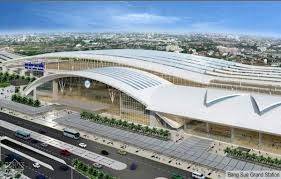Thailand has announced that they are on track to open the largest rail station in all of Southeast Asia, the Bang Sue Grand Station by 2021 as it plans to upgrade the country’s public transport system. It is intended to is relieve Bangkok’s chronic traffic congestion and support the country’s role as a regional transport hub. It will replace Hua Lamphong, the capital’s main station at present. Besides intercity trains, Bang Sue will also serve Bangkok’s metro, commuter, and high-speed trains, and provide fast connections with Suvarnabhumi, Don Mueang, and U-Tapao international airports. According to the ministry, the 220km route between Don Mueang, in the northern outskirts of Bangkok, and U-Tapao in Rayong province could be traveled in less than an hour. Sino-Thai Engineering Construction began work on the structure of the station in 2013 and this has now been completed; work on its interior will be completed in time for the services to begin in 2021.
Also Read: China-Laos railway makes progress with 14.5 km tunnel drilled.
When completed, the 520-hectare station will be the largest in Southeast Asia. It will be four stories high, with 12 platforms up to 600m long and 24 tracks. This will allow it to accommodate up to 40 trains at the same time, with a daily passenger capacity of 600,000, more than 10 times that of Hua Lamphong. At least 30% of its area will be devoted to green spaces and it will be pollution-free since it will serve only electric trains.
Bang Sue Grand Station will be a stop for Thailand’s first high-speed train project, which will run between Bangkok to Nong Khai. The first phase, covering the 251km from Bangkok north to Nakhon Ratchasima, is under construction. The rest of the route linking Nakhon Ratchasima with Nong Khai will cover a distance of 356km. Once completed, this project will enable travelers from Bangkok to reach the Laotian border in three hours, rather than 11 at present. The ministry adds that this line will be extended to link with the rail line being built through Laos as part of China’s Belt and Road Initiative.
